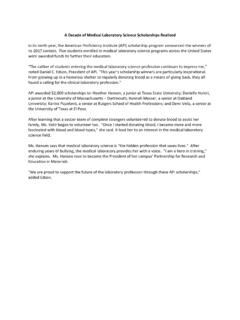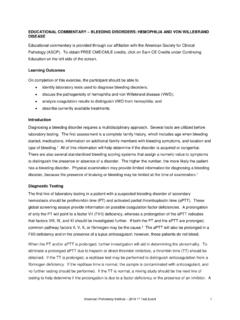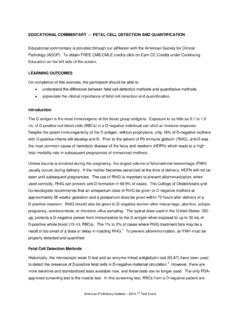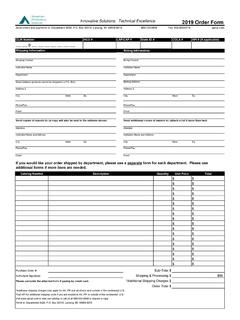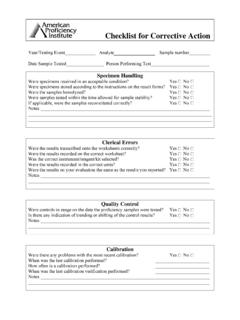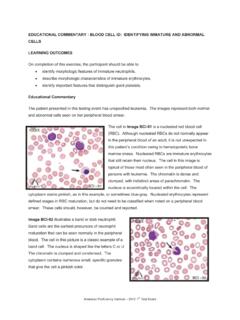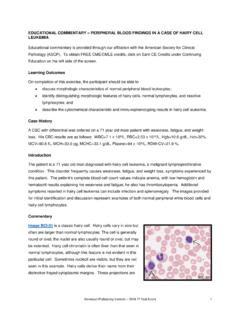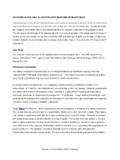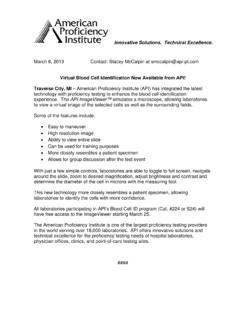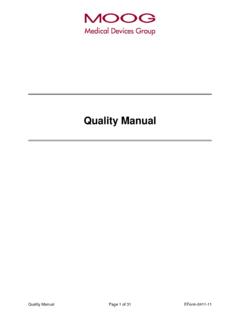Transcription of EDUCATIONAL COMMENTARY COMPETENCY …
1 EDUCATIONAL COMMENTARY COMPETENCY assessment IN THE clinical laboratory : DEVELOPING A COMPETENCY assessment PROGRAM. EDUCATIONAL COMMENTARY is provided through our affiliation with the American Society for clinical Pathology (ASCP). To obtain FREE CME/CMLE credits click on Earn CE Credits under Continuing Education on the left side of the screen. **Florida licensees, please note: This exercise will fulfill your state requirement for credit in Supervision /. Administration. LEARNING OBJECTIVES. On completion of this exercise, the participant should be able to explain the importance of COMPETENCY assessment in fulfilling federal regulations. describe who is responsible for COMPETENCY assessment , who must have their COMPETENCY assessed, and the frequency of the assessment . use examples to explain the 6 methods of COMPETENCY assessment .
2 Define a test system in accordance with federal regulations for COMPETENCY assessment . describe the elements of a COMPETENCY assessment program. Introduction COMPETENCY is the ability to accomplish a task successfully. In the laboratory , this means testing the right sample in the correct way to produce the best result possible for patient care. COMPETENCY must encompass all phases of testing: preanalytic, analytic, and postanalytic. Assessing staff for COMPETENCY can be challenging, but with a comprehensive COMPETENCY assessment program, the task can be a little less daunting. Through regulations set forth by the federal government, it is possible for each individual laboratory to develop an effective COMPETENCY program. The Centers for Medicare & Medicaid Services (CMS) regulates all laboratory testing (except research) performed on humans in the through the clinical laboratory Improvement Amendments (CLIA).
3 In total, CLIA covers approximately 225,000 laboratory entities. The Division of laboratory Services, within the Survey and Certification Group, under the Office of clinical Standards and Quality (OCSQ), has the responsibility for implementing the CLIA. 1. Program. As recorded in the Code of Federal Regulations (CFR) Title 42, Part 493, Subpart M, the clinical laboratory Improvement Amendments of 1988 (CLIA 88) specify standards that laboratories must follow to ensure the COMPETENCY of staff and, therefore, the ultimate quality of the final test result. These American Proficiency Institute 2013 2nd Test Event EDUCATIONAL COMMENTARY COMPETENCY assessment IN THE clinical laboratory : DEVELOPING A COMPETENCY assessment PROGRAM (cont.). standards are available at the CMS website: Guidance/Legislation/ CLIA 88 and 42 CFR will be used to refer to all current standards and their interpretation in the Federal Register.
4 clinical laboratories must establish a COMPETENCY assessment program that meets the federal requirements for a certified laboratory as stated in CLIA 88, as well as the standards of other CMS- approved accrediting agencies such as The Joint Commission, CAP (the College of American Pathologists), and COLA. These agencies refer directly to CLIA 88 regulations for COMPETENCY assessment and may have additional requirements unique to their accreditation. The goal of these regulatory and certifying standards is to ensure that prior to testing patients' specimens, all personnel have the appropriate education and experience, receive the appropriate training for the type and complexity of the services offered, and have demonstrated that they can perform all testing operations 2. reliably to provide and report accurate results.
5 Current regulatory and certifying standards prescribe the following: How COMPETENCY will be assessed and the methods that must be used, Personnel responsible for overseeing COMPETENCY , The individuals who must have their COMPETENCY assessed and the frequency of that assessment , The test systems that fall under the regulation for COMPETENCY assessment . How COMPETENCY Will Be Assessed and the Methods That Must Be Used Six methods are required by CLIA 88 federal regulation to be used to assess COMPETENCY . 1. Direct observations of routine patient test performance, including patient preparation, if applicable, 2. specimen handling, processing and testing; . This method requires a specified individual to observe staff members performing the preanalytic and analytic phases of testing according to written procedures.
6 These procedures can be summarized in a direct observation checklist that addresses the critical steps of a specific procedure to help the observer evaluate each procedure. 2. 2. Monitoring the recording and reporting of test results; . This can be accomplished by reviewing patient records in a laboratory information system, hard copy reports, or patient medical records. Specific elements, such as critical value documentation, accurate reference ranges, corrected reports, and accurate patient demographics are important to the quality of patient data and should be monitored. American Proficiency Institute 2013 2nd Test Event EDUCATIONAL COMMENTARY COMPETENCY assessment IN THE clinical laboratory : DEVELOPING A COMPETENCY assessment PROGRAM (cont.). 3. Review of intermediate test results or worksheets, quality control records, proficiency testing results, 2.
7 And preventive maintenance records; . A method to document the review of the elements mentioned in the standard must be used to ensure that all staff are maintaining quality in the laboratory . The routine review of quality control records and preventive maintenance records should be part of every laboratory 's quality assurance plan. Proficiency test results are reviewed by performing personnel as well as by the laboratory director. Intermediate test results can be reviewed by specified personnel before patient results are reported to look for documentation such as manufacturer kit lot number and expiration date, the date testing was performed, the initials of staff performing the testing, and documentation of kit performance by quality controls. 2. 4. Direct observation of performance of instrument maintenance and function checks.
8 In addition to the review of documentation, a specified individual is also responsible to watch staff perform instrument maintenance and function checks, which are critical to analyzer performance. This method of COMPETENCY assessment ensures that all steps are performed according to the written procedures. Again, an observation checklist with the critical steps summarized is an effective tool for documentation of this method. 5. assessment of test performance through testing previously analyzed specimens, internal blind 2. testing samples or external proficiency testing samples; . This method can be time consuming if there are several staff members to assess. This requires the assessor to prepare unknown samples to be incorporated into the daily workload. As stated, these can be proficiency samples, blind samples, or previously analyzed samples.
9 The number of blind samples assigned to each staff member can be determined by the assessor. The other component of this method is setting an acceptable performance limit. Acceptable standard deviation, coefficient of variation, or CLIA 88 proficiency limits for the test that is assessed are valid methods for setting the acceptable performance limits. 2. 6. assessment of problem solving skills.. Although problem solving skills can be difficult to assess, they are used by laboratory staff every day. Problems encountered include inadequate or mislabeled specimens, troubleshooting instrumentation or reagent performance, and customer complaints. Documentation of these common problems can be used to fulfill this assessment . Other methods that can be used include a case study with questions that relate to laboratory -specific written policies and procedures, a mock demonstration of a written policy, or online continuing education that relates to the test system that is being assessed.
10 It may be beneficial to ask the American Proficiency Institute 2013 2nd Test Event EDUCATIONAL COMMENTARY COMPETENCY assessment IN THE clinical laboratory : DEVELOPING A COMPETENCY assessment PROGRAM (cont.). instrument or reagent manufacturer if they provide tools to assess COMPETENCY , as this is an added value to the laboratory customer. Personnel Responsible for COMPETENCY assessment The laboratory director is ultimately responsible for the oversight of COMPETENCY ; the director authorizes specific responsibilities and duties of supervisors and consultants, and ultimately, of all staff who are involved in all phases of testing. This can be accomplished by means of written job descriptions. The director is also responsible for ensur[ing] that policies and procedures are established for monitoring individuals who conduct preanalytical, analytical, and postanalytical phases of testing to assure that they are competent and maintain their COMPETENCY to process specimens, perform test procedures and report test results promptly and proficiently, and whenever necessary, identify needs for remedial training or 2.

